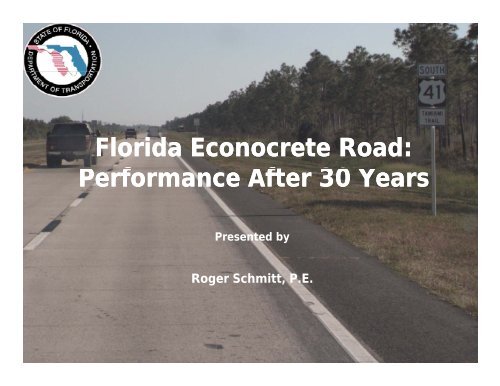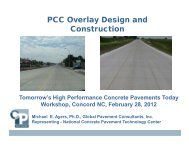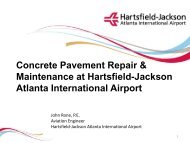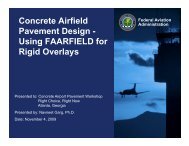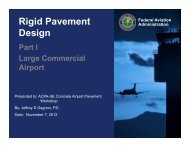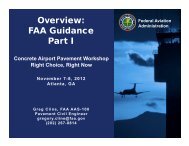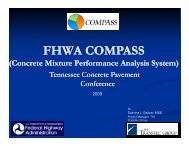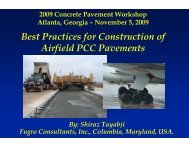30-Year Old Two-Life Pavement Case Study
30-Year Old Two-Life Pavement Case Study
30-Year Old Two-Life Pavement Case Study
You also want an ePaper? Increase the reach of your titles
YUMPU automatically turns print PDFs into web optimized ePapers that Google loves.
Florida Econocrete Road:<br />
Performance After <strong>30</strong> <strong>Year</strong>s<br />
Presented by<br />
Roger Schmitt, P.E.
The FDOT in conjunction with the FHWA<br />
and the ACPA initiated the “Econocrete<br />
Test Road” demonstration research<br />
project in 1974.
What prompted this project ?<br />
• Shortage of high quality aggregates and energy<br />
crisis in the early 70’s<br />
• Depletion of many supply sources of high<br />
quality aggregates in Florida<br />
• Increase in aggregate transportation cost, and<br />
• Energy savings envisioned i in 70’s by use of<br />
econocrete
Purpose :<br />
This project was to determine the feasibility of<br />
construction, and to evaluate the structural<br />
and performance characteristics of a composite<br />
concrete pavement system consisting of a<br />
relatively thin wearing concrete course over an<br />
econocrete base layer.
Project Description<br />
• Contractor<br />
• Completed 1978<br />
Ballenger Paving<br />
• Length<br />
6.5 65 Miles es( (initially)<br />
ta • Southbound Lanes 2<br />
• Test Sections<br />
• Typical Test Section<br />
• Design <strong>Life</strong><br />
33 (initially)<br />
2,000 ft<br />
20 years
Project Location :<br />
The project is on US 41/SR45 in Charlotte<br />
County, Florida, between the cities of Punta<br />
Gorda to the North and Fort Myers to the<br />
South. It includes the two southbound lanes of<br />
a four lane divided highway.
US 41/SR 45<br />
Project Alignment
• Twelve (12) test sections remain in<br />
service today:<br />
-2 (control section)<br />
- 3A, 3B, 3B-1S, 3B-2S, 3C<br />
- 4A, 4B, 4C<br />
- 5A, 5B, 5BT
• Section 2 (Control):<br />
9 in PCC<br />
6 in Cement treated subgrade<br />
20 ft slabs, right angle joints
• Sections 3A, 3B, 3C, 3B1S, 3B2S:<br />
3 in PCC<br />
9 in Econocrete (A=2,000 psi, B=1,250 psi, C=750 psi)<br />
6 in Stabilized subgrade<br />
15 ft slabs, skewed joints<br />
3B1S & 3B2S– have tied econocrete shoulder<br />
with and without rumble strips, respectively .
• Sections 4A, 4B, 4C:<br />
3 in PCC<br />
9 in Econocrete (A=2,000 psi, B=1,250 psi, C= 750 psi)<br />
6 in Cement treated subgrade<br />
15 ft slabs, right angle joints
• Sections 5A, 5B, 5BT:<br />
3 in Dowelled PCC ( 1in dowels @ 12” c/c)<br />
9 in Econocrete (A=2,000 psi, B=1,250 psi)<br />
6 in Stabilized subgrade<br />
20 ft slabs, right angle joints
Condition Survey Results
Cracking<br />
50.0<br />
45.0<br />
40.0<br />
Cracked Slab bs (%)<br />
35.0<br />
<strong>30</strong>.0<br />
25.0<br />
20.0<br />
15.0<br />
10.0<br />
50 5.0<br />
0.0<br />
2 3A 3B 3B1S 3B2S 3C 4A 4B 4C 5A 5B 5BT<br />
Test Sections<br />
Corner Longitudinal Transverse
Cores from Well Performing<br />
Cement Treated Subgrade Sections
Cores from Well Performing<br />
Stabilized Subgrade Sections
Cores from Longitudinal Cracked<br />
Sections<br />
3 C 4 A<br />
4 B 4 C
Smoothness<br />
220<br />
200<br />
180<br />
160<br />
140<br />
IRI (in/mile)<br />
120<br />
100<br />
80<br />
60<br />
40<br />
20<br />
0<br />
2 3A 3B/ALT. 3B1S 3B2S 3C 4A 4B 4C 5A 5B 5BT<br />
Test Sections
FAULTING IN OUTSIDE WHEEL PATH (in).<br />
0.60<br />
0.55<br />
0.50<br />
Faulting > 0.5 in typically requires reconstruction/slab replacement<br />
Faulting (in n) -<br />
0.45<br />
0.40<br />
0.35<br />
0.<strong>30</strong><br />
0.25<br />
0.20<br />
0.15<br />
0.10<br />
0.05<br />
0.00<br />
Faulting > 0.15 in typically requires diamond grinding /other rehabilitation<br />
2 3A 3B 3BIS 3B2S 3C 4A 4B 4C 5A 5B 5BT<br />
Test Section<br />
Avg.<br />
Max.
Observations:<br />
• This project has surpassed its 20 year design life, and<br />
continues to perform well.<br />
• <strong>Pavement</strong> sections made up of a concrete layer laid<br />
bonded to an econocrete layer, have generally shown<br />
better performance than the standard design section (ie<br />
Section 2).<br />
• <strong>Pavement</strong> sections on stabilized subgrade have very little<br />
or no cracking and better smoothness compared to<br />
pavement sections on cement treated subgrade.
Observations (Continued):<br />
• Composite pavement sections on cement treated<br />
subgrade with 15 ft joint spacing have higher load<br />
transfer efficiency compared to the rest of the test<br />
sections<br />
• All test sections have minimal faulting, except for<br />
sections 2 and 4C which require grinding.<br />
• Examination of core samples show that uniformity and<br />
control of the stabilized subgrade material is necessary<br />
to ensure good pavement performance.
Upcoming activities:<br />
• Coring of test sections 2, 5A and 5B<br />
• Testing of cores: compressive and flexural<br />
strength, coefficient of thermal expansion,<br />
and modulus of elasticity of composite<br />
layers<br />
• Analysis of model predicted performance<br />
vs field performance
Thank You !


